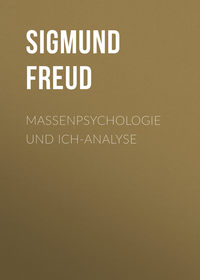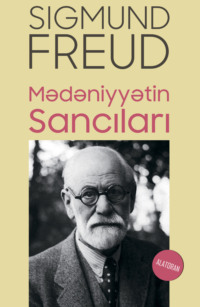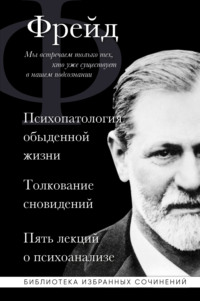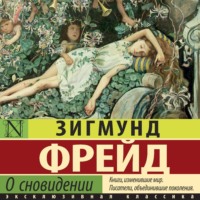
Полная версия
The Interpretation of Dreams / Толкование сновидений
We may here take our choice. We may admit that the laws of the dream formation cannot really be traced any further, and therefore refrain from asking whether or not the interpretation of the illusion evoked by the sensory impression depends upon still other conditions; or we may suppose that the objective sensory stimulus encroaching upon sleep plays only a modest part as a dream source, and that other factors determine the choice of the memory picture to be evoked. Indeed, on carefully examining Maury̕s experimentally produced dreams, which I have purposely reported in detail, one is apt to think that the experiment really explains the origin of only one of the dream elements, and that the rest of the dream content appears in fact too independent, too much determined in detail, to be explained by the one demand, viz. that it must agree with the element experimentally introduced. Indeed one even begins to doubt the illusion theory, and the power of the objective impression to form the dream, when one learns that this impression at times experiences the most peculiar and far-fetched interpretations during the sleeping state. Thus B. M. Simon63 tells of a dream in which he saw persons of gigantic stature[5] seated at a table, and heard distinctly the awful rattling produced by the impact of their jaws while chewing. On waking he heard the clacking of the hoofs of a horse galloping past his window. If the noise of the horse̕s hoofs had recalled ideas from the memory sphere of “Gulliver̕s Travels,” the sojourn with the giants of Brobdingnag and the virtuous horse-creatures – as I should perhaps interpret it without any assistance on the author̕s part – should not the choice of a memory sphere so uncommon for the stimulus have some further illumination from other motives?
II. Internal (Subjective) Sensory Stimuli. – Notwithstanding all objections to the contrary, we must admit that the rôle of the objective sensory stimuli as a producer of dreams has been indisputably established, and if these stimuli seem perhaps insufficient in their nature and frequency to explain all dream pictures, we are then directed to look for other dream sources acting in an analogous manner. I do not know where the idea originated that along with the outer sensory stimuli the inner (subjective) stimuli should also be considered, but as a matter of fact this is done more or less fully in all the more recent descriptions of the etiology of dreams. “An important part is played in dream illusions,” says Wundt36 (p. 363), “by those subjective sensations of seeing and hearing which are familiar to us in the waking state as a luminous chaos in the dark field of vision, ringing, buzzing, etc., of the ears, and especially irritation of the retina. This explains the remarkable tendency of the dream to delude the eyes with numbers of similar or identical objects. Thus we see spread before our eyes numberless birds, butterflies, fishes, coloured beads, flowers, etc. Here the luminous dust in the dark field of vision has taken on phantastic figures, and the many luminous points of which it consists are embodied by the dream in as many single pictures, which are looked upon as moving objects owing to the mobility of the luminous chaos. This is also the root of the great fondness of the dream for the most complex animal figures, the multiplicity of forms readily following the form of the subjective light pictures.”
The subjective sensory stimuli as a source of the dream have the obvious advantage that unlike the objective stimuli they are independent of external accidents. They are, so to speak, at the disposal of the explanation as often as it needs them. They are, however, in so far inferior to the objective sensory stimuli that the rôle of dream inciter, which observation and experiment have proven for the latter, can be verified in their case only with difficulty or not at all. The main proof for the dream-inciting power of subjective sensory excitements is offered by the so-called hypnogogic hallucinations, which have been described by John Müller as “phantastic visual manifestations.” They are those very vivid and changeable pictures which occur regularly in many people during the period of falling asleep, and which may remain for awhile even after the eyes have been opened. Maury,48 who was considerably troubled by them, subjected them to a thorough study, and maintained that they are related to or rather identical with dream pictures – this has already been asserted by John Müller. Maury states that a certain psychic passivity is necessary for their origin; it requires a relaxation of the tension of attention (p. 59). But in any ordinary disposition a hypnogogic hallucination may be produced by merging for a second into such lethargy, after which one perhaps awakens until this oft-repeated process terminates in sleep. According to Maury, if one awakens shortly thereafter, it is often possible to demonstrate the same pictures in the dream which one has perceived as hypnogogic hallucinations before falling asleep (p. 134). Thus it once happened to Maury with a group of pictures of grotesque figures, with distorted features and strange headdresses, which obtruded themselves upon him with incredible importunity during the period of falling asleep, and which he recalled having dreamed upon awakening. On another occasion, while suffering from hunger, because he kept himself on a rather strict diet, he saw hypnogogically a plate and a hand armed with a fork taking some food from the plate. In his dream he found himself at a table abundantly supplied with food, and heard the rattle made by the diners with their forks. On still another occasion, after falling asleep with irritated and painful eyes, he had the hypnogogic hallucination of seeing microscopically small characters which he was forced to decipher one by one with great exertion; having been awakened from his sleep an hour later, he recalled a dream in which there was an open book with very small letters, which he was obliged to read through with laborious effort.
Just as in the case of these pictures, auditory hallucinations of words, names, etc., may also appear hypnogogically, and then repeat themselves in the dream, like an overture announcing the principal motive of the opera which is to follow.
A more recent observer of hypnogogic hallucinations, G. Trumbull Ladd,40 takes the same path pursued by John Müller and Maury. By dint of practice he succeeded in acquiring the faculty of suddenly arousing himself, without opening his eyes, two to five minutes after having gradually fallen asleep, which gave him opportunity to compare the sensations of the retina just vanishing with the dream pictures remaining in his memory. He assures us that an intimate relation between the two can always be recognised, in the sense that the luminous dots and lines of the spontaneous light of the retina produced, so to speak, the sketched outline or scheme for the psychically perceived dream figures. A dream, e. g., in which he saw in front of him clearly printed lines which he read and studied, corresponded to an arrangement of the luminous dots and lines in the retina in parallel lines, or, to express it in his own words: “The clearly printed page, which he was reading in the dream, resolved itself into an object which appeared to his waking perception like part of an actual printed sheet looked at through a little hole in a piece of paper, from too great a distance to be made out distinctly.” Without in any way under-estimating the central part of the phenomenon, Ladd believes that hardly any visual dream occurs in our minds that is not based on material furnished by this inner condition of stimulation in the retina. This is particularly true of dreams occurring shortly after falling asleep in a dark room, while dreams occurring in the morning near the period of awakening receive their stimulation from the objective light penetrating the eye from the lightened room. The shifting and endlessly variable character of the spontaneous luminous excitation of the retina corresponds exactly to the fitful succession of pictures presented to us in our dreams. If we attach any importance to Ladd̕s observations, we cannot underrate the productiveness of this subjective source of excitation for the dream; for visual pictures apparently form the principal constituent of our dreams. The share furnished from the spheres of the other senses, beside the sense of hearing, is more insignificant and inconstant.
III. Internal (Organic) Physical Excitation. – If we are disposed to seek dream sources not outside, but inside, the organism, we must remember that almost all our internal organs, which in their healthy state hardly remind us of their existence, may, in states of excitation – as we call them – or in disease, become for us a source of the most painful sensations, which must be put on an equality with the external excitants of the pain and sensory stimuli. It is on the strength of very old experience that, e. g., Strümpell66 declares that “during sleep the mind becomes far more deeply and broadly conscious of its connection with the body than in the waking state, and it is compelled to receive and be influenced by stimulating impressions originating in parts and changes of the body of which it is unconscious in the waking state.” Even Aristotle1 declares it quite possible that the dream should draw our attention to incipient morbid conditions which we have not noticed at all in the waking state (owing to the exaggeration given by the dream to the impressions; and some medical authors, who were certainly far from believing in any prophetic power of the dream, have admitted this significance of the dream at least for the foretelling of disease. (Compare M. Simon, p. 31, and many older authors.)
Even in our times there seems to be no lack of authenticated examples of such diagnostic performances on the part of the dream. Thus Tissié68 cites from Artigues (Essai sur la Valeur séméiologique des Réves), the history of a woman of forty-three years, who, during several years of apparently perfect health, was troubled with anxiety dreams, and in whom medical examination later disclosed an incipient affection of the heart to which she soon succumbed.
Serious disturbances of the internal organs apparently act as inciters of dreams in a considerable number of persons. Attention is quite generally called to the frequency of anxiety dreams in the diseases of the heart and lungs; indeed this relation of the dream life is placed so conspicuously in the foreground by many authors that I shall here content myself with a mere reference to the literature. (Radestock,54 Spitta,64 Maury, M. Simon, Tissié.) Tissié even assumes that the diseased organs impress upon the dream content their characteristic features. The dreams of persons suffering from diseases of the heart are generally very brief and terminate in a terrified awakening; the situation of death under terrible circumstances almost always plays a part in their content. Those suffering from diseases of the lungs dream of suffocation, of being crowded, and of flight, and a great many of them are subject to the well-known nightmare, which, by the way, Boerner has succeeded in producing experimentally by lying on the face and closing up the openings of the respiratory organs. In digestive disturbances the dream contains ideas from the sphere of enjoyment and disgust. Finally, the influence of sexual excitement on the dream content is perceptible enough in every one̕s experience, and lends the strongest support to the entire theory of the dream excitation through organic sensation.
Moreover, as we go through the literature of the dream, it becomes quite obvious that some of the authors (Maury,48 Weygandt75) have been led to the study of dream problems by the influence of their own pathological state on the content of their dreams.
The addition to dream sources from these undoubtedly established facts is, however, not as important as one might be led to suppose; for the dream is a phenomenon which occurs in healthy persons – perhaps in all persons, and every night – and a pathological state of the organs is apparently not one of its indispensable conditions. For us, however, the question is not whence particular dreams originate, but what may be the exciting source for the ordinary dreams of normal persons.
But we need go only a step further to find a dream source which is more prolific than any of those mentioned above, which indeed promises to be inexhaustible in every case. If it is established that the bodily organs become in sickness an exciting source of dreams, and if we admit that the mind, diverted during sleep from the outer world, can devote more attention to the interior of the body, we may readily assume that the organs need not necessarily become diseased in order to permit stimuli, which in some way or other grow into dream pictures, to reach the sleeping mind. What in the waking state we broadly perceive as general sensation, distinguishable by its quality alone, to which, in the opinion of the physicians, all the organic systems contribute their shares – this general sensation at night attaining powerful efficiency and becoming active with its individual components – would naturally furnish the most powerful as well as the most common source for the production of the dream presentations. It still remains, however, to examine according to what rule the organic sensations become transformed into dream presentations.
The theory of the origin of dreams just stated has been the favourite with all medical authors. The obscurity which conceals the essence of our being – the “moi splanchnique,” as Tissié terms it – from our knowledge and the obscurity of the origin of the dream correspond too well not to be brought into relation with each other. The train of thought which makes organic sensation the inciter of the dream has besides another attraction for the physician, inasmuch as it favours the etiological union of the dream and mental diseases, which show so many agreements in their manifestations, for alterations in the organic sensations and excitations emanating from the inner organs are both of wide significance in the origin of the psychoses. It is therefore not surprising that the theory of bodily sensation can be traced to more than one originator who has propounded it independently.
A number of authors have been influenced by the train of ideas developed by the philosopher Schopenhauer in 1851. Our conception of the universe originates through the fact that our intellect recasts the impressions coming to it from without in the moulds of time, space, and causality. The sensations from the interior of the organism, proceeding from the sympathetic nervous system, exert in the day-time an influence on our mood for the most part unconscious. At night, however, when the overwhelming influence of the day̕s impressions is no longer felt, the impressions pressing upward from the interior are able to gain attention – just as in the night we hear the rippling of the spring that was rendered inaudible by the noise of the day. In what other way, then, could the intellect react upon these stimuli than by performing its characteristic function? It will transform the stimuli into figures, filling space and time, which move at the beginning of causality; and thus the dream originates. Scherner,58 and after him Volkelt,72 attempted to penetrate into closer relations between physical sensations and dream pictures; but we shall reserve the discussion of these attempts for the chapter on the theory of the dream.
In a study particularly logical in its development, the psychiatrist Krauss39 found the origin of the dream as well as of deliria and delusions in the same element, viz. the organically determined sensation. According to this author there is hardly a place in the organism which might not become the starting point of a dream or of a delusion. Now organically determined sensations “may be divided into two classes: (1) those of the total feeling (general sensations), (2) specific sensations which are inherent in the principal systems of the vegetative organism, which may be divided into five groups: (a) the muscular, (b) the pneumatic, (c) the gastric, (d) the sexual, (e) the peripheral sensations (p. 33 of the second article).”
The origin of the dream picture on the basis of the physical sensations is conceived by Krauss as follows: The awakened sensation evokes a presentation related to it in accordance with some law of association, and combines with this, thus forming an organic structure, towards which, however, consciousness does not maintain its normal attitude. For it does not bestow any attention on the sensation itself, but concerns itself entirely with the accompanying presentation; this is likewise the reason why the state of affairs in question should have been so long misunderstood (p. 11, etc.). Krauss finds for this process the specific term of “transubstantiation of the feeling into dream pictures” (p. 24).
That the organic bodily sensations exert some influence on the formation of the dream is nowadays almost universally acknowledged, but the question as to the law underlying the relation between the two is answered in various ways and often in obscure terms. On the basis of the theory of bodily excitation the special task of dream interpretation is to trace back the content of a dream to the causative organic stimulus, and if we do not recognise the rules of interpretation advanced by Scherner,58 we frequently find ourselves confronted with the awkward fact that the organic exciting source reveals itself in the content of the dream only.
A certain agreement, however, is manifested in the interpretation of the various forms of dreams which have been designated as “typical” because they recur in so many persons with almost the same contents. Among these are the well-known dreams of falling from heights, of the falling out of teeth, of flying, and of embarrassment because of being naked or barely clad. This last dream is said to be caused simply by the perception felt in sleep that one has thrown off the bedcover and is exposed. The dream of the falling out of teeth is explained by “dental irritation,” which does not, however, of necessity imply a morbid state of excitation in the teeth. According to Strümpell,66 the flying dream is the adequate picture used by the mind to interpret the sum of excitation emanating from the rising and sinking of the pulmonary lobes after the cutaneous sensation of the thorax has been reduced to insensibility. It is this latter circumstance that causes a sensation related to the conception of flying. Falling from a height in a dream is said to have its cause in the fact that when unconsciousness of the sensation of cutaneous pressure has set in, either an arm falls away from the body or a flexed knee is suddenly stretched out, causing the feeling of cutaneous pressure to return to consciousness, and the transition to consciousness embodies itself psychically as a dream of falling. (Strümpell, p. 118). The weakness of these plausible attempts at explanation evidently lies in the fact that without any further elucidation they allow this or that group of organic sensations to disappear from psychic perception or to obtrude themselves upon it until the constellation favourable for the explanation has been established. I shall, however, later have occasion to recur to typical dreams and to their origin.
From comparison of a series of similar dreams, M. Simon63 endeavoured to formulate certain rules for the influence of the organic sensations on the determination of the resulting dream. He says (p. 34): “If any organic apparatus, which during sleep normally participates in the expression of an affect, for any reason merges into the state of excitation to which it is usually aroused by that affect, the dream thus produced will contain presentations which fit the affect.”
Another rule reads as follows (p. 35): “If an organic apparatus is in a state of activity, excitation, or disturbance during sleep, the dream will bring ideas which are related to the exercise of the organic function which is performed by that apparatus.”
Mourly Vold73 has undertaken to prove experimentally the influence assumed by the theory of bodily sensation for a single territory. He has made experiments in altering the positions of the sleeper̕s limbs, and has compared the resulting dream with his alterations. As a result he reports the following theories:-
1. The position of a limb in a dream corresponds approximately to that of reality, i. e. we dream of a static condition of the limb which corresponds to the real condition.
2. When one dreams of a moving limb it always happens that one of the positions occurring in the execution of this movement corresponds to the real position.
3. The position of one̕s own limb may be attributed in the dream to another person.
4. One may dream further that the movement in question is impeded.
5. The limb in any particular position may appear in the dream as an animal or monster, in which case a certain analogy between the two is established.
6. The position of a limb may incite in the dream ideas which bear some relation or other to this limb. Thus, e. g., if we are employed with the fingers we dream of numerals.
Such results would lead me to conclude that even the theory of bodily sensation cannot fully extinguish the apparent freedom in the determination of the dream picture to be awakened.[6]
IV. Psychic Exciting Sources. – In treating the relations of the dream to the waking life and the origin of the dream material, we learned that the earliest as well as the latest investigators agreed that men dream of what they are doing in the day-time, and of what they are interested in during the waking state. This interest continuing from waking life into sleep, besides being a psychic tie joining the dream to life, also furnishes us a dream source not to be under-estimated, which, taken with those stimuli which become interesting and active during sleep, suffices to explain the origin of all dream pictures. But we have also heard the opposite of the above assertion, viz. that the dream takes the sleeper away from the interests of the day, and that in most cases we do not dream of things that have occupied our attention during the day until after they have lost for the waking life the stimulus of actuality. Hence in the analysis of the dream life we are reminded at every step that it is inadmissible to frame general rules without making provision for qualifications expressed by such terms as “frequently,” “as a rule,” “in most cases,” and without preparing for the validity of the exceptions.
If the conscious interest, together with the inner and outer sleep stimuli, sufficed to cover the etiology of the dreams, we ought to be in a position to give a satisfactory account of the origin of all the elements of a dream; the riddle of the dream sources would thus be solved, leaving only the task of separating the part played by the psychic and the somatic dream stimuli in individual dreams. But as a matter of fact no such complete solution of a dream has ever been accomplished in any case, and, what is more, every one attempting such solution has found that in most cases there have remained a great many components of the dream, the source of which he was unable to explain. The daily interest as a psychic source of dreams is evidently not far-reaching enough to justify the confident assertions to the effect that we all continue our waking affairs in the dream.
Other psychic sources of dreams are unknown. Hence, with the exception perhaps of the explanation of dreams given by Scherner,58 which will be referred to later, all explanations found in the literature show a large gap when we come to the derivation of the material for the presentation pictures, which is most characteristic for the dream. In this dilemma the majority of authors have developed a tendency to depreciate as much as possible the psychic factor in the excitations of dreams which is so difficult to approach. To be sure, they distinguish as a main division of dreams the nerve-exciting and the association dreams, and assert that the latter has its source exclusively in reproduction (Wundt,76 p. 365), but they cannot yet dismiss the doubt whether “they do not appear without being impelled by the psychical stimulus” (Volkelt,72 p. 127). The characteristic quality of the pure association dream is also found wanting. To quote Volkelt (p. 118): “In the association dreams proper we can no longer speak of such a firm nucleus. Here the loose grouping penetrates also into the centre of the dream. The ideation which is already set free from reason and intellect is here no longer held together by the more important psychical and mental stimuli, but is left to its own aimless shifting and complete confusion.” Wundt, too, attempts to depreciate the psychic factor in the stimulation of dreams by declaring that the “phantasms of the dream certainly are unjustly regarded as pure hallucinations, and that probably most dream presentations are really illusions, inasmuch as they emanate from slight sensory impressions which are never extinguished during sleep” (p. 338, etc.). Weygandt75 agrees with this view, but generalises it. He asserts that “the first source of all dream presentations is a sensory stimulus to which reproductive associations are then joined” (p. 17). Tissié68 goes still further in repressing the psychic exciting sources (p. 183): “Les rêves d̕origine absolument psychique n̕existent pas”; and elsewhere (p. 6), “Les pensées de nos rêves nous viennent de dehors…”














